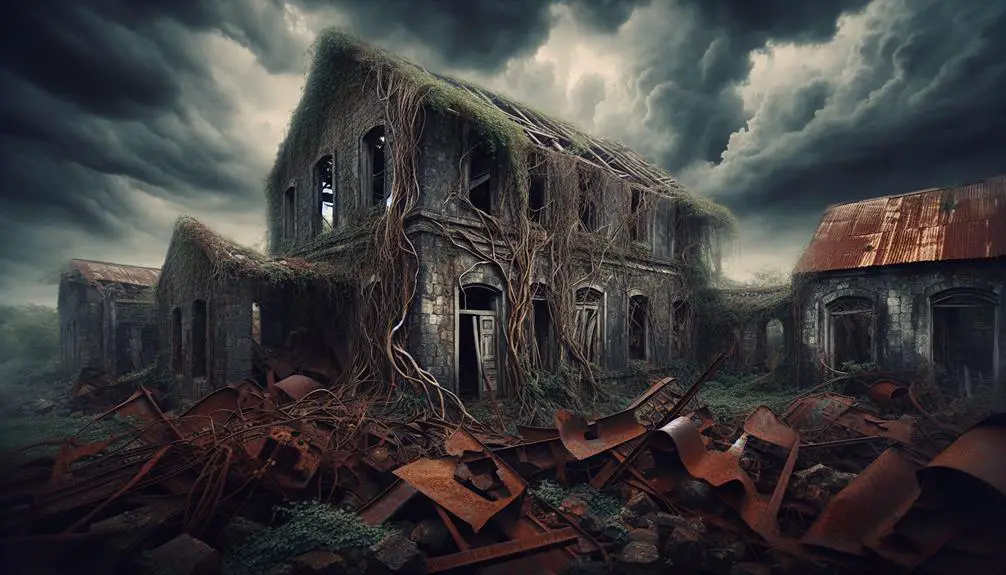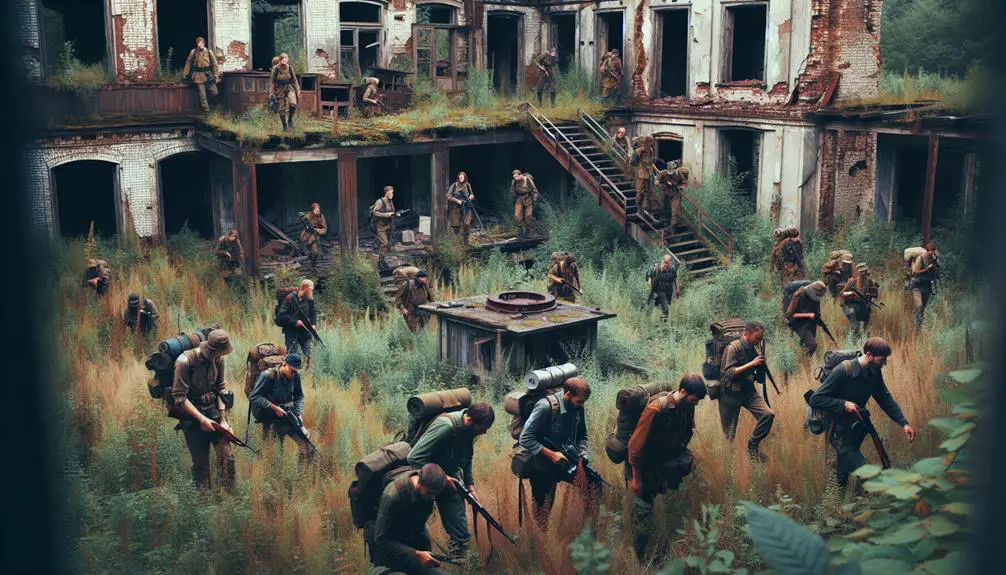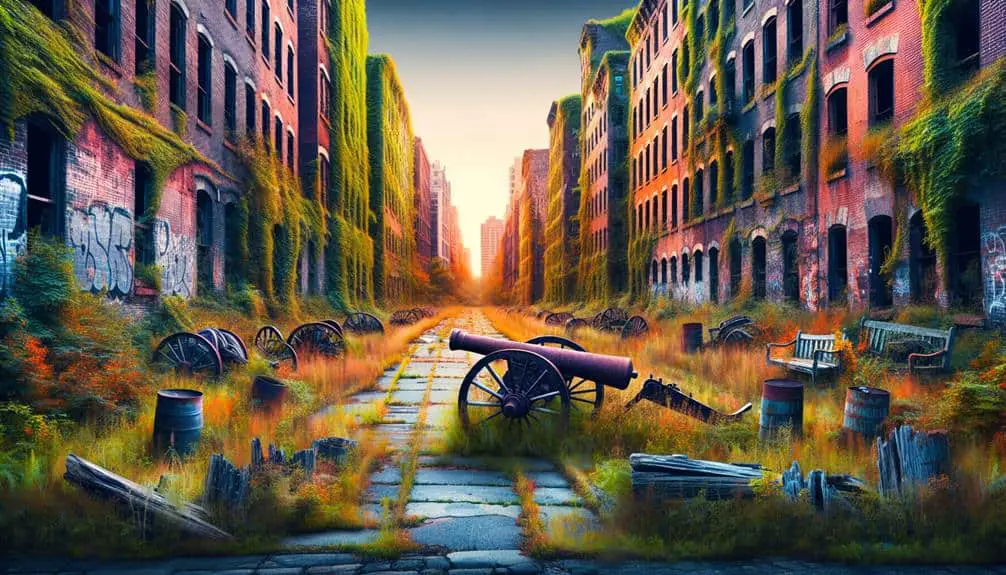In Civil War ghost towns, relics like household items, tools, and structural remains endure, telling stories of past lives. These artifacts offer insights into daily activities and town layouts, preserving a unique historical narrative. Challenges include natural decay, vandalism risks, and delicate preservation needs. Safeguarding relics is crucial for cultural heritage, with tourism potential and technological enhancements on the horizon. The essence of history lives on in these relics, waiting to reveal more tales of a forgotten era.
Key Points
- Household items like utensils, ceramics, and glassware offer insights into daily life.
- Tools such as farming equipment and mining gear reflect past activities.
- Structural remains reveal town layouts and construction methods from the era.
- Personal items like jewelry and photographs provide glimpses into individual stories.
- Preservation efforts aim to safeguard relics for cultural heritage and historical understanding.
Significance of Civil War Relics
Significantly, Civil War relics serve as tangible connections to a pivotal moment in history, providing invaluable insights into the past through their material remains. These artifacts hold immense cultural significance, embodying the struggles, sacrifices, and triumphs of individuals who lived through the Civil War era. Each relic, whether a uniform button, a musket ball, or a canteen, serves as a poignant reminder of the human experiences tied to that turbulent time.
Historical preservation efforts play a vital role in safeguarding these relics for future generations. By conserving and showcasing Civil War artifacts, we guarantee that the stories of those who fought and lived during this period aren't lost to time. Museums, historical societies, and collectors all contribute to the ongoing effort of preserving these items, allowing us to learn from the past and honor the legacy of those who came before us. The meticulous care and attention given to these relics highlight their enduring importance in understanding and appreciating our shared history.
Preservation Efforts in Ghost Towns
Preservation efforts in ghost towns are crucial to safeguard their historical significance and cultural heritage. Techniques vary but often include stabilizing structures to prevent decay, documenting artifacts and structures through photography and mapping, and creating detailed descriptions. Community involvement is key, with local residents, historians, and volunteers collaborating to protect and maintain these sites. Community clean-up days, fundraising events, and educational programs raise awareness and foster a sense of ownership and pride in preserving ghost towns. These collective efforts ensure that these historical places remain intact for future generations.
Preservation techniques in ghost towns vary depending on the specific needs of each site. One common method involves stabilizing structures to prevent further decay. This can include repairing roofs, reinforcing walls, and protecting buildings from environmental factors such as rain and wind. Another important aspect of preservation is the documentation of artifacts and structures through photography, mapping, and detailed descriptions. By creating a record of these elements, future generations can better understand the history of the town.
Community involvement plays a pivotal role in the preservation of ghost towns. Local residents, historians, and volunteers often work together to make sure that these sites are protected and maintained. Community clean-up days, fundraising events, and educational programs help raise awareness about the importance of preserving these historical places. By fostering a sense of ownership and pride in the town's history, communities can guarantee that ghost towns remain intact for years to come.
Common Relics Found in Abandoned Towns
Numerous artifacts and remnants can often be unearthed in abandoned towns, shedding light on the lives and activities of past residents. When exploring these ghost towns, it's crucial to pay attention to artifact identification and historical context analysis. Common relics found in these deserted areas include household items like utensils, ceramics, and glassware, providing insights into the daily routines of the former inhabitants. Additionally, tools such as farming equipment, mining gear, and carpentry instruments hint at the primary industries or occupations in the town.
Structural remains like building foundations, bricks, and architectural fragments reveal the town's layout and construction techniques. Personal items like jewelry, clothing accessories, and photographs offer a glimpse into the social aspects and personal stories of the people who once called these places home. By meticulously cataloging and studying these artifacts, historians and archaeologists can piece together a more thorough understanding of the town's history and the lives of its residents.
Challenges of Protecting Historical Artifacts
Exploring the remnants of a Civil War ghost town presents a vital set of challenges when it comes to protecting historical artifacts. The challenges arise due to the delicate nature of these artifacts and the need for preservation to maintain their historical significance. Conservation efforts play an essential role in safeguarding these relics for future generations, but they face obstacles that require careful navigation.
One of the primary challenges in protecting historical artifacts from Civil War ghost towns is the threat of natural deterioration. Exposure to the elements, such as rain, wind, and sunlight, can cause irreversible damage to these artifacts over time. Conservation efforts must include measures to shield these relics from environmental factors through proper storage and maintenance.
Furthermore, the risk of vandalism and theft poses a significant challenge to the conservation of historical artifacts. Ghost towns often attract curious visitors and opportunistic individuals who may not appreciate the importance of these relics. Implementing security measures and raising awareness about the value of these artifacts are essential components of safeguarding them.
Future of Civil War Ghost Town Relics
Preserving the relics from Civil War ghost towns requires strategic planning and innovative conservation methods to guarantee their longevity and cultural significance. As we look to the future of these historical artifacts, here are some key considerations:
- Cultural Heritage: It's essential to continue efforts in preserving Civil War ghost town relics to safeguard our rich cultural heritage for future generations.
- Tourism Potential: These relics have significant tourism potential, attracting history enthusiasts and curious visitors alike. Developing sustainable tourism around these sites can help generate awareness and support for their preservation.
- Technological Advancements: Embracing new technologies such as 3D scanning and virtual reality can offer immersive experiences for visitors while preserving the relics themselves.
- Community Engagement: Involving local communities in the preservation efforts can foster a sense of ownership and pride, ensuring continued support for maintaining these valuable remnants of our past.
Frequently Asked Questions
How Do Historians Determine the Authenticity of Civil War Relics Found in Ghost Towns?
To determine the authenticity of Civil War relics in ghost towns, historians use radiocarbon dating for dating materials and conservation techniques to preserve them. These methods help in validating the historical significance of discovered artifacts.
Are There Any Superstitions or Ghost Stories Associated With These Abandoned Towns and Their Relics?
Exploring abandoned towns stirs curiosity about haunted tales and folklore. Supernatural occurrences fuel paranormal investigations. Immerse in stories of the unknown, where relics hold secrets, blending history with mystery in ghostly whispers under moonlit skies.
What Are Some Lesser-Known Ways That Technology Is Being Used to Study and Preserve Civil War Artifacts in Ghost Towns?
To study and preserve civil war artifacts in ghost towns, technology like 3D scanning and digital preservation is essential. These methods provide detailed replicas and archives, ensuring these historical relics are documented and accessible.
Are There Any Famous Individuals or Events From the Civil War Era That Have Left Traces in These Abandoned Towns?
When exploring the remnants of Civil War ghost towns, you'll encounter traces of famous battles and notable figures. It's akin to unearthing Revolutionary War secrets or unraveling the mysteries of the Underground Railroad.
What Are Some of the Most Unusual or Unexpected Relics That Have Been Discovered in Ghost Towns From the Civil War Era?
Uncover the eerie charm of Civil War ghost towns. Excavate haunting artifacts and supernatural mysteries. Unearth unexpected treasures and forgotten secrets. These relics whisper tales of a bygone era, inviting you to explore history's enigmatic depths.



